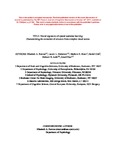Neural Signatures of Spatial Statistical Learning: Characterizing the Extraction of Structure from Complex Visual Scenes
| dc.contributor.author | Karuza, EA | |
| dc.contributor.author | Emberson, LL | |
| dc.contributor.author | Roser, ME | |
| dc.contributor.author | Cole, D | |
| dc.contributor.author | Aslin, RN | |
| dc.contributor.author | Fiser, J | |
| dc.date.accessioned | 2017-11-27T15:19:40Z | |
| dc.date.issued | 2017-12 | |
| dc.identifier.issn | 0898-929X | |
| dc.identifier.issn | 1530-8898 | |
| dc.identifier.uri | http://hdl.handle.net/10026.1/10289 | |
| dc.description.abstract |
<jats:title>Abstract</jats:title> <jats:p>Behavioral evidence has shown that humans automatically develop internal representations adapted to the temporal and spatial statistics of the environment. Building on prior fMRI studies that have focused on statistical learning of temporal sequences, we investigated the neural substrates and mechanisms underlying statistical learning from scenes with a structured spatial layout. Our goals were twofold: (1) to determine discrete brain regions in which degree of learning (i.e., behavioral performance) was a significant predictor of neural activity during acquisition of spatial regularities and (2) to examine how connectivity between this set of areas and the rest of the brain changed over the course of learning. Univariate activity analyses indicated a diffuse set of dorsal striatal and occipitoparietal activations correlated with individual differences in participants' ability to acquire the underlying spatial structure of the scenes. In addition, bilateral medial-temporal activation was linked to participants' behavioral performance, suggesting that spatial statistical learning recruits additional resources from the limbic system. Connectivity analyses examined, across the time course of learning, psychophysiological interactions with peak regions defined by the initial univariate analysis. Generally, we find that task-based connectivity with these regions was significantly greater in early relative to later periods of learning. Moreover, in certain cases, decreased task-based connectivity between time points was predicted by overall posttest performance. Results suggest a narrowing mechanism whereby the brain, confronted with a novel structured environment, initially boosts overall functional integration and then reduces interregional coupling over time.</jats:p> | |
| dc.format.extent | 1963-1976 | |
| dc.format.medium | Print-Electronic | |
| dc.language | en | |
| dc.language.iso | en | |
| dc.publisher | MIT Press - Journals | |
| dc.subject | Adolescent | |
| dc.subject | Adult | |
| dc.subject | Brain | |
| dc.subject | Humans | |
| dc.subject | Magnetic Resonance Imaging | |
| dc.subject | Models, Statistical | |
| dc.subject | Neural Pathways | |
| dc.subject | Neuropsychological Tests | |
| dc.subject | Psychophysics | |
| dc.subject | Spatial Learning | |
| dc.subject | Time Factors | |
| dc.subject | Visual Perception | |
| dc.subject | Young Adult | |
| dc.title | Neural Signatures of Spatial Statistical Learning: Characterizing the Extraction of Structure from Complex Visual Scenes | |
| dc.type | journal-article | |
| dc.type | Journal Article | |
| plymouth.author-url | https://www.webofscience.com/api/gateway?GWVersion=2&SrcApp=PARTNER_APP&SrcAuth=LinksAMR&KeyUT=WOS:000414016400001&DestLinkType=FullRecord&DestApp=ALL_WOS&UsrCustomerID=11bb513d99f797142bcfeffcc58ea008 | |
| plymouth.issue | 12 | |
| plymouth.volume | 29 | |
| plymouth.publication-status | Accepted | |
| plymouth.journal | Journal of Cognitive Neuroscience | |
| dc.identifier.doi | 10.1162/jocn_a_01182 | |
| plymouth.organisational-group | /Plymouth | |
| plymouth.organisational-group | /Plymouth/Faculty of Health | |
| plymouth.organisational-group | /Plymouth/Faculty of Health/School of Psychology | |
| plymouth.organisational-group | /Plymouth/REF 2021 Researchers by UoA | |
| plymouth.organisational-group | /Plymouth/REF 2021 Researchers by UoA/UoA04 Psychology, Psychiatry and Neuroscience | |
| plymouth.organisational-group | /Plymouth/Research Groups | |
| plymouth.organisational-group | /Plymouth/Research Groups/Centre for Brain, Cognition and Behaviour (CBCB) | |
| plymouth.organisational-group | /Plymouth/Research Groups/Centre for Brain, Cognition and Behaviour (CBCB)/Brain | |
| plymouth.organisational-group | /Plymouth/Users by role | |
| plymouth.organisational-group | /Plymouth/Users by role/Academics | |
| dc.publisher.place | United States | |
| dcterms.dateAccepted | 2017-08-10 | |
| dc.identifier.eissn | 1530-8898 | |
| dc.rights.embargoperiod | Not known | |
| rioxxterms.versionofrecord | 10.1162/jocn_a_01182 | |
| rioxxterms.licenseref.uri | http://www.rioxx.net/licenses/all-rights-reserved | |
| rioxxterms.licenseref.startdate | 2017-12 | |
| rioxxterms.type | Journal Article/Review |


